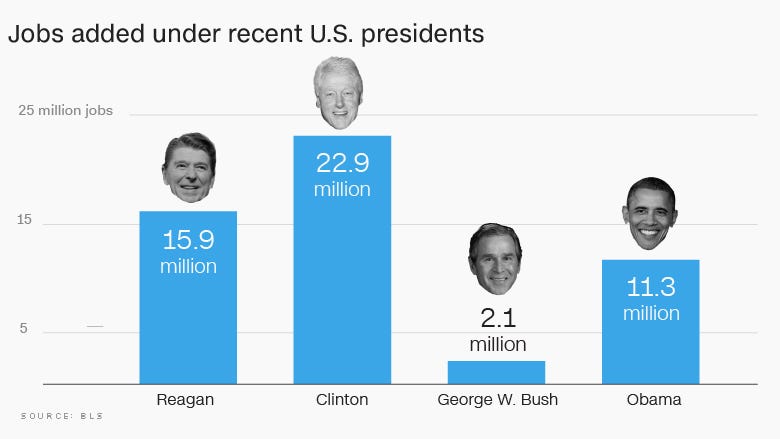
In his first days in office, President Donald Trump has launched a major effort to hurt job growth, stifle innovation, and make Americans sicker and less productive. How? By waging war on regulations, particularly those designed to protect the environment.
Trump ran on a pledge to kill regulations, and focused much of his wrath on EPA climate rules such as the Clean Power Plan. Upon assuming office, he put in place a “freeze” on all federal regulations; told business leaders “we’re going to be cutting regulation massively” by 75 percent or “maybe more”; and told car company executives that environmental regulations are “out of control.”
Yet, contrary to popular myth, regulations such as clean air and water standards do not have a net negative impact on job growth. Indeed, studies have found that the exact type of regulations Trump is targeting actually spur innovation and competitiveness.

As Bureau of Labor Statistics data make clear (above chart), the recent two-term presidents who were in favor of regulation, especially environmental regulation (Obama and Clinton) created vastly more net jobs than the anti-regulation Presidents (Reagan and George W. Bush). “Businesses have added jobs at a nearly 2.5 times faster rate under Democrats than under Republicans, on average,” the U.S. Congress Joint Economic Committee reported in June.
The multiple economic benefits of regulations are well documented. First, EPA regulations make companies invest money to reduce some of the damage that results from their operation— such as polluting the air or water. That investment directly creates jobs, which generally cancel out any jobs lost by the cost imposed on the polluters.
Second, the reduction in harm itself boosts growth—cleaner air, for instance, means fewer sick days lost to asthma or cardiopulmonary illness. Here, for instance, are the health and mortality benefits of EPA Clean Air Act programs since 1990 aimed at reducing fine particles and ozone levels:

EPA particulate regulations (PM2.5) alone are now saving some 200,000 lives a year. And the benefits to the economy of these health improvements are enormous. The loss in economic output due to restricted activity, sickness, and death is enormous.
Indeed, the 2016 “Draft Report to Congress on the Benefits and Costs of Federal Regulations” by the Office of Management and Budget found that over the previous 10 years, EPA’s air regulations cost the economy $41 to $48 billion (in 2014$) while providing benefits worth $172 to $668 billion.
The same report found that Energy Department efficiency standards—which Trump has also frozen—cost the economy $7.5 to $10.6 billion but provided $19 to $32.6 billion in savings. And it found that the joint EPA and Transportation Department “rules pertaining to the control of greenhouse gas emissions from mobile sources and improved vehicle fuel economy” had costs of $9.5 to $18 billion and benefits worth $35 to $64 billion.
Third, beyond those direct costs and benefits, environmental regulations spur innovation. This was the key notion that Harvard Business School professor and competitiveness guru Michael Porter first suggested in the 1990s. Subsequent reviews of the economic literature on the so-called “Porter Hypothesis” confirmed he was right. Indeed, the most recent studies confirm Porter’s broader theory that “stricter regulation enhances business performance.”
It’s worth noting that a comprehensive peer-reviewed analysis of the performance of the U.S. economy in the past six decades found that “growth in total factor productivity was much faster under Democrats (1.89 percent versus 0.84 percent for Republicans).” So if anyone’s policies are hurting productivity, it would appear to be the GOP’s.
Finally, in the coming decades, the ever-worsening reality of climate change will ensure that the primary new manufacturing jobs will be green and sustainable. In 2010, the New York Times reported “in the energy sector alone, the deployment of new technologies, like wind and solar power, has the potential to support 20 million jobs by 2030 and trillions of dollars in revenue, analysts estimate.”

The Paris climate deal—unanimously agreed upon by 190 nations in December 2015—means that the potential revenues generated for cleantech in the coming decades will be measured in the tens of trillions of dollars.
This potential is quickly becoming a reality. Other countries, especially China, have used regulations and investment to become leaders in clean energy technologies like solar and wind. And now China is using the same strategy with batteries and electric vehicles (EVs) to capture what is projected to be an EV market of more than 37 million in 2025.
But Trump intends to kill the very policies and regulations that would give the U.S. a piece of what is becoming the largest collection of new job-creating industries.
So, tragically, Trump’s war on regulations will not only kill countless U.S. jobs, it will kill a lot of people.
This post appeared originally in Think Progress on January 25, 2017. Reprinted with permission.
Dr. Joe Romm is a Fellow at American Progress and is the founding editor of Climate Progress, which New York Times columnist Tom Friedman called “the indispensable blog” and Time magazine named one of the 25 “Best Blogs of 2010.” In 2009, Rolling Stone put Romm #88 on its list of 100 “people who are reinventing America.” Time named him a “Hero of the Environment? and “The Web’s most influential climate-change blogger.” Romm was acting assistant secretary of energy for energy efficiency and renewable energy in 1997, where he oversaw $1 billion in R&D, demonstration, and deployment of low-carbon technology. He holds a Ph.D. in physics from MIT.




